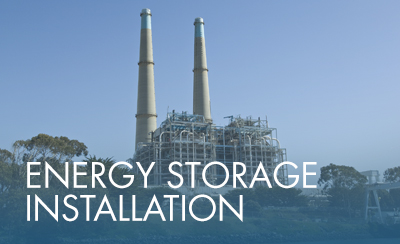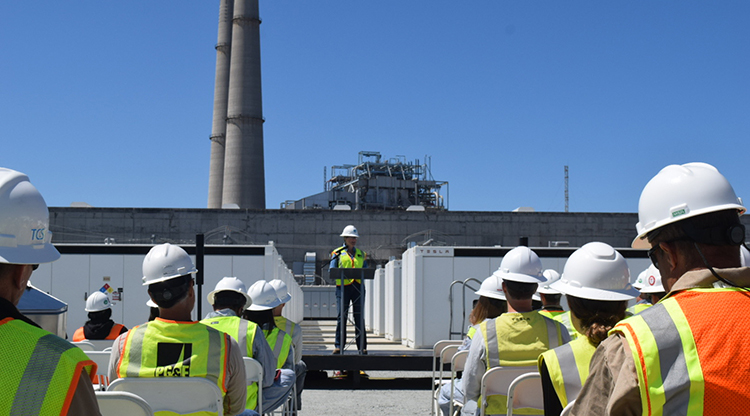< Back to blog
“A golden age of energy storage”
June 14, 2022
 Just a few years ago, the notion that battery storage would play a key role in California’s energy future was seen by many as a quixotic dream for an emerging technology not yet reliable or cost-effective enough to be counted on.
Just a few years ago, the notion that battery storage would play a key role in California’s energy future was seen by many as a quixotic dream for an emerging technology not yet reliable or cost-effective enough to be counted on.
But in the past year alone, as California accelerates its transition to a carbon-free electric grid by 2045, there is a growing appreciation that battery storage has arrived in a big way, that it is performing well and playing an increasingly greater role in the state’s energy future.
That was the strong, unambiguous message delivered last week at a symbolic ribbon cutting for PG&E’s Moss Landing Elkhorn Battery System near Monterey Bay, one of the latest in a flurry of new battery installations connected to the grid over the past year.
“We’re making the future that our grandchildren and our grandchildren’s children can be proud of,” Patti Poppe, PG&E’s CEO, said on a gorgeous June morning on the coast. “And maybe they won’t even know because we’ll have made it so seamless for them to have clean, reliable and safe (energy) that powers the lives and prosperity that they dream of. We’re making that happen and we’re making that happen right here.”

PG&E, in collaboration with Tesla, the pioneering electric vehicle and lithium-ion battery manufacturer, began operating the 182.5 megawatt (MW) site on April 7 of this year. The facility, which can provide enough electricity for about 275,000 homes for up to four hours, is part of a dramatic ramping up of battery resources on the California grid as it continues to transition from fossil fuels to more renewable power. Electricity generated by the lithium-ion batteries, charged during the day when solar energy is usually abundant, is typically dispatched after the sun has set and solar is not available.
“This capability is particularly helpful on hot summer evenings when temperatures are high in California and in other regions, which creates sustained very high demand for electricity and actually limits our ability to import electricity from other states,” Elliot Mainzer, president and CEO of the California Independent System Operator, said at the Moss Landing event. “So that ability to reinject that power right after sunset is super valuable from the perspective of reliability. It’s a key part of our strategy going forward.”
Mainzer called the influx of battery storage capacity on the grid over the past year “an incredible growth curve, an incredible success story,” adding that “We’ve entered a golden age of energy storage here in California.” The ISO now has more than 3,160 MW of battery storage connected to the grid and is expected to add another 700 MW by the end of June.
David Hochschild, chair of the California Energy Commission, also spoke at the Moss Landing event, calling it “a great milestone on our journey to build a clean energy future together, a future beyond fossil fuels of clean air and a stable climate.”
Almost two-thirds of the state’s electricity is now coming from clean, carbon-free sources, he said, and California is adding about 100 electric vehicles to the roadways per day. “It’s more important than ever that as we do that, the electric grid is stable, the electric grid is reliable, and that’s what you’re seeing right here,” Hochschild said.”
In addition to the environmental benefits of being able to dispatch clean power that does not emit greenhouse gases, Poppe stressed the economic advantages of storing solar energy when it’s abundant and relatively inexpensive for use later in the day. That’s often when the electricity is most needed and when PG&E would otherwise have to pay more for the energy it requires to meet net-peak demand for customers.
“Just this year already, back in April, just days after being fully energized and connected to the grid, we were charging the battery at $10 a MW/hour midday when we had ample, abundant renewable clean energy resources,” she said. “Fast forward to peak that very same day, power was selling at $100 a MW/hour and this resource was dispatching to the grid.
“That saves money for our customers and brings clean energy that otherwise would have been diesel-generated fossil-fuel-powered resources. People I think sometimes speculate, is California going too far with clean energy? Heck no, we’re just getting started and a facility like this makes it possible. And that day back in mid-April proved it.”
Other economic benefits were highlighted as well. Hochschild stressed the good jobs and careers that are being created in California as the state shifts to greater electrification and a clean grid. And Michael Snyder, Tesla’s director of energy projects and engineering, said the 256 Tesla Megapack battery units at Moss Landing were manufactured at Tesla’s new “mega-factory” two hours away in Lathrop. When that factory is at full capacity, it will be able to produce enough batteries to build the equivalent of 50 of the Moss Landing facilities per year for use in California and around the world, he said.
With the Moss Landing site now online, PG&E officials said the utility currently has 955.5MW of battery storage capacity connected to the grid. Contracts have also been executed for large-scale battery systems that can generate more than 3,300MW of capacity by the end of 2024. “The good news,” Poppe said, “is we’re not stopping here. The clean energy transition is happening and it’s happening here and PG&E is leading the way and we couldn’t be more excited.”
< Back to blog